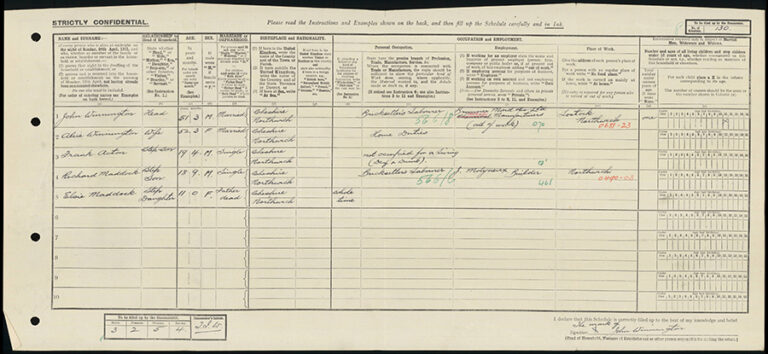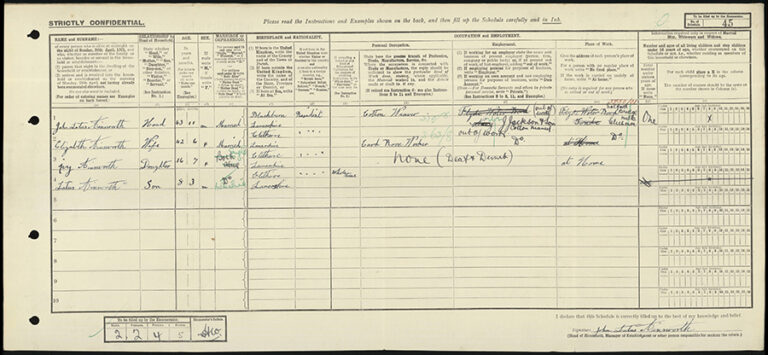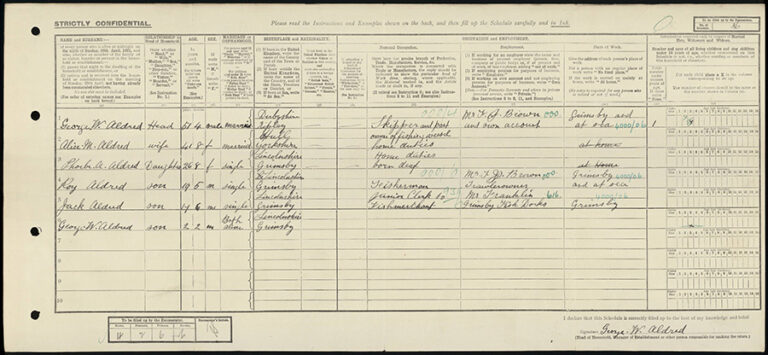The release of a census always provides a wealth of research potential, and the 1921 Census is no different. The census has previously been a particularly useful source for disability and particularly for Deaf history because the data collection covered a range of conditions which the general population were considered able to identify themselves. Being deaf was one such condition.
In previous iterations of the census in England and Wales, between 1851 and 1911, there was a column which was termed the ‘infirmity column’, where some options were listed, allowing the general public at large to self-declare whether they or any member of their household fitted the criteria. In 1911 the column heading read as follows:
‘If any person included in this Schedule is :-
(1) “Totally Deaf” or “Deaf and Dumb”
(2) “Totally Blind”
(3) “Lunatic”, or
(4) “Imbecile” or “Feebleminded,”
state the infirmity opposite that person’s name, and the age at which he or she became afflicted.’
While the diagnostic terminology used is of its era, and most of it not appropriate for use today, it does provide a potentially useful source for tracing disability and Deaf history.
The contemporary authorities were not convinced of the value of this data, however, and the minutes of the General Register Office’s Census committee in 1919 record that ‘weighty evidence has been placed before the committee to the effect that, owing to the difficulties of definition and unwillingness on the part of the householder to give information, the results obtained from this column are inaccurate and misleading, and that information relating to infirmities is in fact better obtained from other sources than that of the general census.’ This recommendation was published by the Royal Statistical Society in the same year, and consequently, the column did not appear on the 1921 Census household schedule.
In the 1911 Census, 26,649 people reported as ‘totally deaf’ and a further 15,122 as ‘deaf and dumb’. The ratio of men to women in these categories was 40:60, and 55:45. Of this nearly 42,000 strong population, around 13% were under the age of 15 and around 20% were over the age of 65, with the remaining 67% between 16 and 65. This group represents 0.12% of the general population, according to these statistics. However, the Deaf population was almost certainly larger than this, as the Registrar General’s office believed that many people simply did not fill in this column, and because this was not recorded in 1921 in the Census, we do not have a figure to work with from this source.
There are lots of reasons why one might be interested in Deaf history. It’s a rich and vibrant culture, with many fascinating insights. Most researchers looking at the 1921 Census are probably interested in the returns of nuclear families resident in typical households, and of course those interested in Deaf history can also take advantage of these too. But, as has been established, there is no column included on the form specifically to document whether someone is deaf or not, so how do you go about tracing deaf people in this source?
Using the advanced search, it is possible to run a keyword search for ‘deaf’ which reveals over 5,000 hits. A good number of these relate to the various Deaf schools around England and Wales, documenting both Deaf students but also teachers of the Deaf, but not all. The Deaf Hill Coal Company, based in County Durham throws some curve balls into these results, for example. By restricting the search to schedules which are not institutions (i.e. the I, II, and III forms), this number drops to around 2,000, which reveals a mix of results. Some of these results come about due to place names, such as Deaf Hill. Some relate to teachers of the Deaf who are not resident in the schools where they teach. And some relate to individuals who have declared themselves to be deaf, or where an annotation has been added documenting this detail.
On the schedule for Anne Maria Mitchell, a 69-year-old woman living in Wantage, for example, a note has been added in a different handwriting under her name which reads ‘nb. Deaf and Dumb’ (RG 15/05924/23), while on the schedule for the Abbot household in Bermondsey, three daughters are working while their father, William, is listed as ‘no work deaf cripple’ (RG 15/01942/96). In Northwick, a 19-year-old by the name of Frank Acton is living with his mother and step-father, and under occupation it reads ‘not occupied for a living – Deaf & Dumb)’ (RG 15/16922/130). Sixteen-year-old Ivy Ainsworth was living with her parents and younger brother in Clitheroe, and also has ‘none – Deaf & Dumb’ recorded as her occupation (RG 15/20323/45). Twenty-six-year-old Phoebe Aldred, living at home in Grimsby with her parents and three younger brothers, has her occupation listed as ‘Home Duties (born deaf)’ (RG 15/15492/36).

Likewise, 21-year-old Joseph Adams, was living in Leeds with his parents. He was employed as a leather liner, and under place of occupation is recorded ‘at home – Deaf & Dumb’ (RG 15/22082/10). It is clear that although the authorities do not ask for this information, there is nonetheless an opportunity to record it, and many people did so.

There are also several examples of families recording their Deaf children on the household, even though they are actually away at Deaf School somewhere else in the country. Thirteen-year-old Grace Dockerill, living with her parents and older brother in Cambridge, has ‘deaf & dumb’ noted where it should say how often she attends school, but this seems to have slipped the enumerator’s notice when the form was returned and so this little gem of information has been retained, rather than being crossed through (RG 15/08151/10).

There is one other aspect of the history of deafness which can begin to be traced through the 1921 Census, and that is the impact of the First World War. Many soldiers developed what we would now recognise as occupational hearing loss, as a result of their proximity to artillery fire or after associated trauma or other injury. One such man was Alfred Field, a painter and decorator from Margate, who recorded his employment as ‘ex-soldier – serious deafness through raids’ (RG 15/04441/359). His return shows that, formerly a painter and decorator, Alfred was now unemployed after his return from the First World War. Undoubtedly, there were many other comparable stories, and the 1921 Census presents a potential source to trace the impact of war through injury and illness in the immediate aftermath.
There are other ways one can begin to trace Deaf people in the 1921. The prominence of residential institutions means that many Deaf children and young adults may be separated from their families on the census, and therefore, as Findmypast began working on the 1921 Census, they tried to think of ways to help those with a Deaf history interest to locate such individuals. To this end, the team at Findmypast, led by Steve Rigden, made a point of noting institutions (primarily residential homes and schools) that they came across. In due course, these were included in a table along with other types of institution which feature in the 1921 Census. This is freely available on the Findmypast website.
However, it’s also nice to show the same information a little more visually, so there is also a Google Map which they created to demonstrate this. This maps the locations (approximate in most cases) of the institutions and contains a link to the first page of the census return, which usually shows the head of the institution and staff before moving on to the residents.
The returns themselves are a minimum of four images long and often much longer, sometimes running to tens of pages. For reference, the address of the institution is found on the last image (which would actually have been the front page when the original schedule was folded up back in the summer of 1921).
There is a lot of potential for this sort of research, and I hope this blog provides some potential avenues for tracing people in the 1921 Census. I’d be delighted to hear of any such work, now or in the future.
Thanks – that was really interesting. My name is Emmeline Burdett and I am one of the co-editors of a blog journal called Public Disability History. I wondered if you might be interested in submitting a post for us on this subject, or on anything else disability history related? You can see the sorts of things that other people have written about at http://www.public-disabilityhistory.org.
Best wishes,
Emmeline Burdett
Thanks Emmeline – I’ll be in touch soon. Best wishes.
Population 42,000? (mentioned above). Should that read 42 million? Or have I misunderstood the context?
Hi Brian. 42,000 is the population of people recorded in the 1911 Census as either Deaf and Dumb, or Totally Deaf, combined.
Interesting and timely blog – thank you. I am currently researching London County Council blind, deaf and crippled scholars who were part of the scheme in the first two decades of the twentieth century. The 1921 census has been useful in adding detail about scholars’ subsequent employment history*. Interestingly quite a few of the men were out of work in 1921, perhaps affected by the return of ex-soldiers to employment. Women were mainly employed as dressmakers (quite a few working for Jay’s Mourning Warehouse on Regent Street) and do not seem to have been affected in the same way. I am now turning my attention to deaf culture more widely, as my research has revealed that many deaf scholars had links to the various deaf churches in London. *it would not be obvious from census entries that any of my scholars were deaf – the best way of maximising the 1921 census in this context is by combining it with another source
My paternal grandparents, Walter Edwin Graves and Dorrie Louisa Graves ( Pells) were both deaf and dumb but were able to work.
Interesting that Blind and Partially sighted are not options on the 1911 Census. My father’s Uncle James attended the Newcastle School for the blind and I was able to access the school records in the archives up there. Hopefully Deaf schools records have also survived, the blind children certainly got up to mischief and I’m sure the deaf schools had similar problems with their students.
Interesting to see. However the small detail cannot be read easily as the definition you have used is very low which is a pity.
This is very interesting and I was not aware of the availability of this information. My family in Australia has a hereditary hearing loss so I will looking to see if my grandparents are recorded with this loss or other close relatives.
As an amateur genealogist for over 50 years I have enjoyed tracing my extensive wide family down the generations and noted a dozen or more “cousins” declared deaf.
Is it hereditary?
I ask as I rely on two hearing aids and lip reading myself.
This article is worthy of reprinting in the RNID magazine I subscribe to.
Thanks very much for the suggestion John – I will get in touch with the RNID to see if they might be interested!
I work in Auditory Cochlear Implants and this has been fascinating (but sad) reading.
The ‘Deaf & Dumb Times publication was also interesting (again sad ) reading. Obviously the language used is not acceptable today, but a crucial medium for the deaf community in the 1800’s who could of course read.
A very apt read for Deaf awareness Week 2-8 May 2022
Many Thanks for this article, I have a deaf relation Arthur Chitty who lived at the time of the 1911/21 Census, who was Deaf, unlike today where we acknowledge those with special needs, he defied an image of being deaf, meaning he was also of low intelligence, in 1889 he passed his apprenticeship as a Book Binder, I have in my possession his apprentice exam pieces of a Bible and Prayer Book , he gave them to his sister who in turn passed them to my mother in the 1950s following her Baptism in the Church of England, and she then passed them on to me, Sadly there was either no work in Book Binding or he just changed his mind as I found him in a later Census as working in a Public house in Camberwell .
I would like to know more about Black Deaf/ Colored Deaf documents.
Evon Black
The 1921 Census also provides information on women in Broadmoor (some were there for 40, 50 or 60 years) for child murders whereas sane defendants were released from prisons after no more than seven years or nothing at all. It’s a question linking up available data, of course the 1921 Census has many transcription errors.
Please note, 19 year old Frank Acton was born in Northwich, Cheshire and not as you have transcribed.
Hello there.
I have been researching my family tree. Currently looking at siblings of my Grandparents who were born and bred in Salford.
My Grandfather James Taylor was the youngest of 5 siblings. I have been having a lot of trouble finding information about one of his sister Alice Taylor. I have found records of her birth in 1 Jun 1911. She was born just after the 1911 British Census was taken and not in the family home on the 1921 Census. A turbulent time for the family with the father being killed in France during WW1 in 1915.
Last night I came across a War pensions record that has answered some questions but opened up many more.
I hope you can view the document.
But next to her name there is an +, There are also a couple of notes referring to Alice only. In the bottom right, from what I can make out reads
“+ Pens. For Alice an inmate of Rl School for Deaf & Dumb, Old Trafford, M/C. Issued only for the period of School holidays. T.G informed 30/8/18”
Her fathers pension may have been paying for tuition/boarding fees at the School.
As soon as I read that, a memory popped into my head of when I was quite young, my grandmother telling me of someone who was “deaf and dumb” I am not 53 and can not remember the conversation, but do remember thinking the term “deaf and dumb” was not very appropriate. That is all I remember, don’t know who it was about or any other reference.
I did a lot of searching of the history of the schools during the war and the development of the school up until today
My enquiry is to see if there would be school records of attendance, information of the students etc. From what I read online last night the schools were boardingschools and also called asylums. Which creates very negative thoughts.
The fact she was not on the 1921 BritishCensus would lead me to believe she may have been boarding at the school.
Is there anywhere I could find any information regarding my Great Aunt, Alice Taylor and her life as a deaf student?
Kind Regards
Robert Taylor
Ps. I typed this elsewhere.
I now have a few documents of Alice beginning at the school.
A copy of her fathers WW1Pension Card, a contract and doctors assessment, copy of the 1922 Census with the front and back cover and the page Alice is listed.
I have also found she married a mute fellow (name unknown) and had two hearing children, a bit and a girl (only first name, no last name).
I’ve just read at the bottom. Not be able to respond to personal family history questions.
But I sure would like to be contacted if anyone could assist.